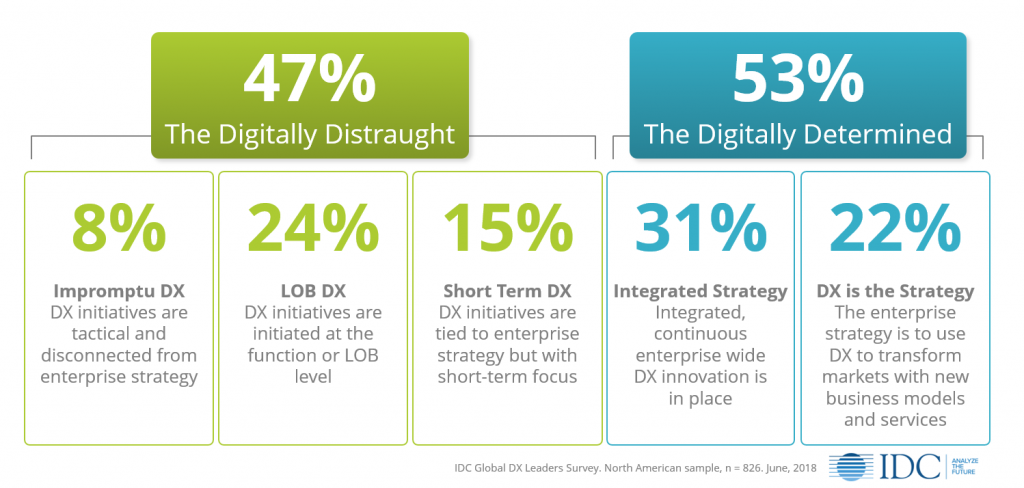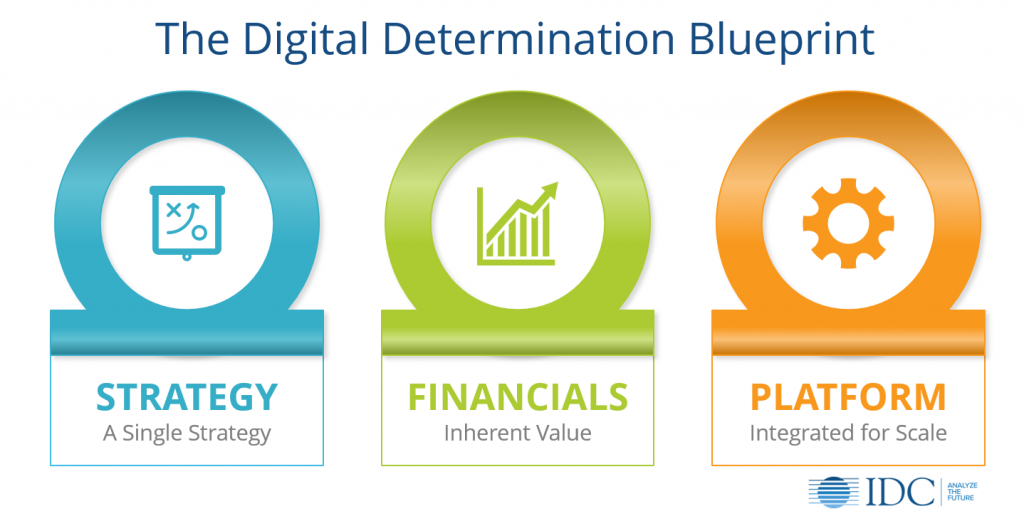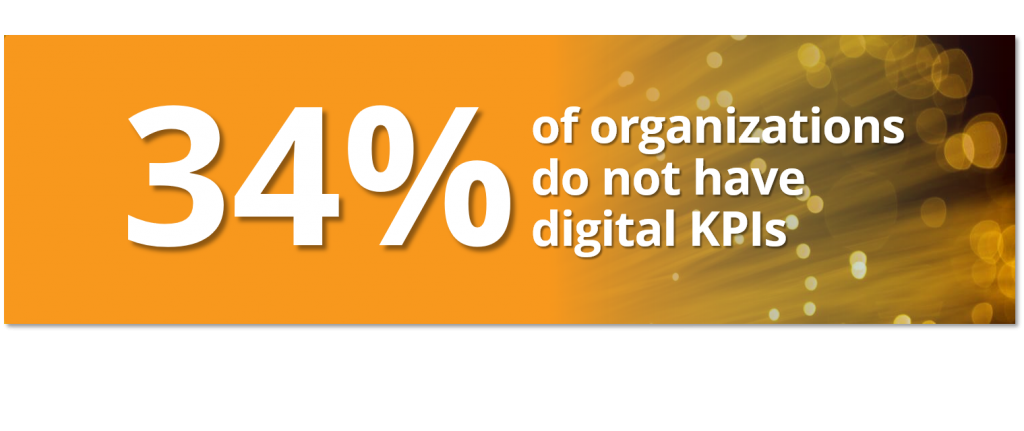This past Spring, I spoke with numerous digital leaders who are feeling distraught. They know what needs to be done but feel a lack of empowerment. Either their CEO is not making the difficult organizational moves, or their organization has multiple strategies, or their investors are taking a short-term view when it comes to funding decisions. These are some of the challenges they feel they cannot overcome on their own.
These digital leaders are distressed because they sense their organization is wavering on digital. At the same time, they see other organizations going all in with digital and overcoming these issues – they see their competitors’ digital determination.
In our recent global survey of digital leaders, we separated out the digitally determined (53% of N.A. organizations) from the digitally distraught (47% of N.A. organizations).

The digitally distraught are either running digital as an impromptu effort; running multiple digital strategies initiated by the line of business; or operating with a short-term perspective. It is no wonder these organizations are distraught. It is difficult to accomplish a major transformation when one’s efforts are not unified, or there are expectations for hefty return on investment in the short term.
By contrast, our study found 31% of the digitally determined have an integrated strategy, where continuous enterprise-wide digital innovation is in place. Even better, we found another 22% of organizations report that digital transformation is the entire business strategy.
IDC has created a blueprint of the principles the digitally determined organizations follow. It tackles the largest obstacles organizations are facing around strategy, financials and scale. If your clients are wavering on their digital strategy, we suggest you walk them through the blueprint to identify which areas they are most struggling with.

A Single Strategy
We find the digitally determined have a single strategy and work off a single digital roadmap. Compare this to the digitally distraught who are trying to coordinate multiple roadmaps. It is important for digital roadmaps to span multiple horizons and extend beyond the typical 3-5-year time frame.
For each horizon, a portion of the roadmap will be comprised of business use cases.
- The Horizon 1 portion of the roadmap consists of the use cases deploying today and the underlying technology to support them.
- The Horizon 2 portion includes the use cases being incubated.
- The Horizon 3 portion focuses on the possibilities of future use cases. There may be no action to take today because the technology is not available. But it is still important for organizations to keep it on the roadmap as it provides perspective when making technical decisions.
In building such a roadmap across horizons, an organization moves from the executable to the more abstract. Most of the digitally distraught have roadmaps that solely focus on use cases in Horizon 1. This can be problematic because these organizations do not think through how their use cases will scale and what technologies they should be experimenting with.
Inherent Value of Digital
When it comes to financials, we see the digitally determined demonstrate the inherent value digital brings to the business.
DBS Bank developed a methodology to calculate the value of a digital customer to the bank versus their traditional customers. During their investor day, the CFO made the case that digital customers deliver higher return on equity compared to the traditional customers because they have a:
- Lower cost to acquire;
- Lower unit cost to serve;
- Higher income per customer year on year;
- And are a faster growing customer base.
They made their case that digital transformation is inherently good for the business and therefore investors should continue to fund their projects to replace IT systems, change the culture to reflect that of digital natives, and create a customer-centric bank.

Part of the equation for demonstrating the inherent value of digital is developing new KPIs that measure the impact of digital on the organization. If one is creating a new business, it stands to reason one needs a new set of success metrics to communicate the change to employees and investors. Yet 34% of organizations have not created new digital KPIs. The digital metrics should capture some of the newer elements of the business such as innovation, customer centricity, monetizing data, digital business operations, and a change to the workforce.
Integrated for Scale
We also see the digitally determined are creating a digital platform that allows them to scale their innovations. There are several competing ideas about what the digital platform should look like. Should it be two separate technology environments – one for the core IT platform and another for the digital innovation – connected by APIs? Should it be an external facing platform serving a network of customers and partners that use and pay for the information and services?
We see the digitally determined building a third type of platform – one that integrates the new digital innovation and the enterprise-wide systems together in a single platform. The platform enables digital products, services, and experiences while modernizing and integrating the internal IT environment.
Digital transformation is not for the faint of heart. An organization needs determination to stay the course when it gets tough. Technology suppliers have a critical role to play. Help your clients make the business case for digital by linking your technology solutions back to the business outcomes. Help your clients build long term digital roadmaps by identifying the use cases for today as well as those for the future. Lastly, discuss with your clients how to scale the digital innovations they are creating.
Learn more about the tools an organization needs to facilitate digital transformation and become digitally determine; download IDC’s interactive eBook, “Preparing for the Digital Transformation Economy.”




